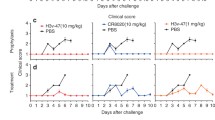Summary
Using neutralizing monoclonal antibodies, three categories of escape mutants were selected from a stock of wild-type infectious bursal disease virus (IBDV). Additional mutants were found, where alterations coexisted in two or three of these epitopes. Although each group of mutants had a distinct reaction pattern with neutralizing monoclonal antibodies, all types of mutants were neutralized by convalescent chicken sera to the same extent. In spite of the lack of homogeneity in these antigenic sites located on IBDV structural polypeptide VP2, all neutralizing monoclonal antibodies reacted with epitopes in extracts prepared from the bursa of Fabricius from animals that had died during recent outbreaks of infectious bursal disease in the F.R.G. and Africa. Since binding to VP2 of the escape mutants, demonstrable by immunoprecipitation, correlated with the neutralizing capacity of these antibodies, a combined immunoprecipitation-immunoblotting technique was established as equivalent for a neutralization assay. The results of our experiments indicate that IBDV did not undergo a major antigenic variation in these two areas of Europe and Africa. The significance of protein conformation for the interaction of VP2 with neutralizing antibodies was underlined by the finding that renatured VP2 was capable of binding neutralizing antibodies; the antibodies induced in animals by immunization with this protein, however, were not neutralizing.
Similar content being viewed by others
References
Porterfield JS (1989) Andrewes' viruses of vertebrates. Baillière Tindall, London
Azad AA, Jagadish MN, Brown MA, Hudson PJ (1987) Deletion mapping and expression inEscherichia coli of the large genomic segment of a birnavirus. Virology 161: 145–152
Bayliss CD, Spies U, Shaw K, Peters RW, Papageorgiou A, Müller H, Boursnell MEG (1990) A comparison of the sequences of segment A of four infectious bursal disease virus strains and identification of a variable region in VP2. J Gen Virol 71: 1303–1312
Becht H (1980) Infectious bursal disease virus. Curr Top Microbiol Immunol 90: 107–121
Becht H, Müller H, Müller HK (1988) Comparative studies on structural and antigenic properties of two serotypes of infectious bursal disease virus. J Gen Virol 69: 631–640
Box PG (1989) High maternal antibodies help chicks beat virulent virus. World Poultry 53: 17–19
Brown F (1986) The classification and nomenclature of viruses: summary of results of meetings of the International Committee on Taxonomy of Viruses in Sendai, September 1984. Intervirology 25: 141–143
Chettle NJ, Eddy RK, Wyeth PJ (1985) The isolation of infectious bursal disease virus from turkeys in England. Br Vet J 141: 141–145
Chettle NJ, Stuart JC, Wyeth PJ (1989) Outbreak of virulent infectious bursal disease in East Anglia. Vet Rec 125: 271–272
Cursiefen D, Vielitz E, Landgraf H, Becht H (1979) Evaluation of a vaccine against infectious bursal disease in field trials. Avian Pathol 8: 341–351
Dobos P, Hill PJ, Hallett R, Kells DTC, Becht H, Teninges D (1979) Biophysical and biochemical characterization of five animal viruses with bisegmented double-stranded genomes. J Virol 32: 593–605
Fahey KJ, Erny K, Crooks J (1989) A conformational immunogen on VP2 of infectious bursal disease virus that induces virus-neutralizing antibodies that passively protect chickens. J Gen Virol 70: 1473–1481
Jackwood DH, Saif YM (1987) Antigenic diversity of infectious bursal disease viruses. Avian Dis 31: 766–770
Khyse-Anderson J (1984) Electroblotting of multiple gels: a simple apparatus without buffer tank for rapid transfer of proteins from polyacrylamide to nitrocellulose. J Biochem Biophys Methods 10: 203–209
Kibenge FSB, Dhillon AS, Russell RG (1988) Biochemistry and immunology of infectious bursal disease virus. J Gen Virol 69: 1757–1775
Laemmli UK (1970) Cleavage of structural proteins during the assembly of the head of bacteriophage T4. Nature 227: 680–685
Maniatis T, Fritsch EF, Sambrook J (1982) Molecular cloning: a laboratory manual. Cold Spring Harbor Laboratory, Cold Spring Harbor, NY
Mc Ferran JB, Mc Nulty MS, Killop ER, Connor TJ, Mc Cracken RM, Collins PS, Allan GM (1980) Isolation and serological studies with infectious bursal disease virus from fowl, turkeys and ducks: demonstration of a second serotype. Avian Pathol 9: 395–404
Müller H, Scholtissek C, Becht H (1979) The genome of infectious bursal disease virus consists of two segments of double-stranded RNA. J Virol 31: 584–589
Müller H, Becht H (1982) Biosynthesis of virus-specific proteins in cells infected with infectious bursal disease virus and their significance as structural elements for infectious virus and incomplete particles. J Virol 44: 384–392
Nick H, Cursiefen D, Becht H (1976) Structural and growth characteristics of infectious bursal disease virus. J Virol 18: 227–234
Ramig RF (1990) Principles of animal virus genetics. In: Fields BN, Knipe BM (eds) Virology, vol 2, 2nd edn. Raven Press, New York, pp 95–122
Snyder DB, Lana DP, Savage PK, Yancey FS, Mengel SA, Marquardt WW (1988) Differentiation of infectious bursal disease viruses directly from infected tissues with neutralizing monoclonal antibodies: evidence of a major antigenic shift in recent field isolates. Avian Dis 32: 535–539
Stuart JC (1989) Acute infectious bursal disease in poultry. Vet Rec 125: 281
Weber K, Kuter DJ (1971) Reversible denaturation of enzymes by sodium dodecyl sulfate. J Biol Chem 246: 4504–4509
Author information
Authors and Affiliations
Rights and permissions
About this article
Cite this article
Öppling, V., Müller, H. & Becht, H. Heterogeneity of the antigenic site responsible for the induction of neutralizing antibodies in infectious bursal disease virus. Archives of Virology 119, 211–223 (1991). https://doi.org/10.1007/BF01310671
Received:
Accepted:
Issue Date:
DOI: https://doi.org/10.1007/BF01310671



